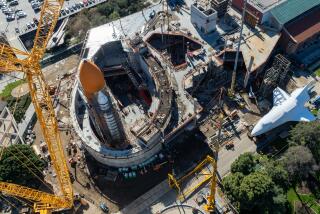Discovery Streaks Aloft With Super-Telescope
- Share via
CAPE CANAVERAL, Fla. — The space shuttle Discovery streaked into orbit today with a revolutionary telescope that will enable astronomers to peer out into space almost to the beginning of time.
About 380 miles above Earth, five NASA astronauts tested the $2.5-billion Hubble Space Telescope’s systems and satellite relays in preparation for releasing the telescope from the shuttle’s payload bay Wednesday.
“The astronomers are starting to tingle again in anticipation of what Hubble will be able to accomplish,” said NASA’s chief scientist, Lennard Fisk. “We are going to have the ability to observe the most distant objects, among the earliest in the universe, and thus probe the secrets of creation,” Fisk said.
The first pictures from the telescope, of a star cluster in the Milky Way galaxy, will be relayed to Earth in about seven days, Fisk said.
The shuttle blasted off at 8:34 a.m. EDT after a tense, three-minute delay while launch controllers fixed a computer programming error that halted the countdown with 31 seconds to go.
“Liftoff of space shuttle Discovery with the Hubble Space Telescope, a new window on the universe,” launch commentator George Diller said as the shuttle bolted from its seaside launch pad into a blue Florida sky.
One of a dozen jets that steer Discovery in space stopped working 10 minutes into the flight, but the National Aeronautics and Space Administration said the malfunction would not hinder efforts to deploy the 25,000-pound telescope.
As soon as they reached orbit, the astronauts began preparing for the culmination of a combined 25 years of training.
Mission specialist Steven Hawley exercised the Canadian-built robot arm, which he will use Wednesday to pluck the railroad car-sized telescope from Discovery’s payload bay.
The daylong operation is scheduled to begin about 7:30 a.m. EDT Wednesday, with actual deployment at 1:57 p.m. EDT, NASA said.
The telescope is named for Edwin P. Hubble, an astronomer who originated the theory of an expanding universe in the 1920s.
Astronomers think the telescope could help them prove that the universe originated from a “big bang” as long as 20 billion years ago.
Discovery flew after a two-week delay for replacement of a failed auxiliary power unit it uses for steering on liftoff.
More to Read
Sign up for Essential California
The most important California stories and recommendations in your inbox every morning.
You may occasionally receive promotional content from the Los Angeles Times.













